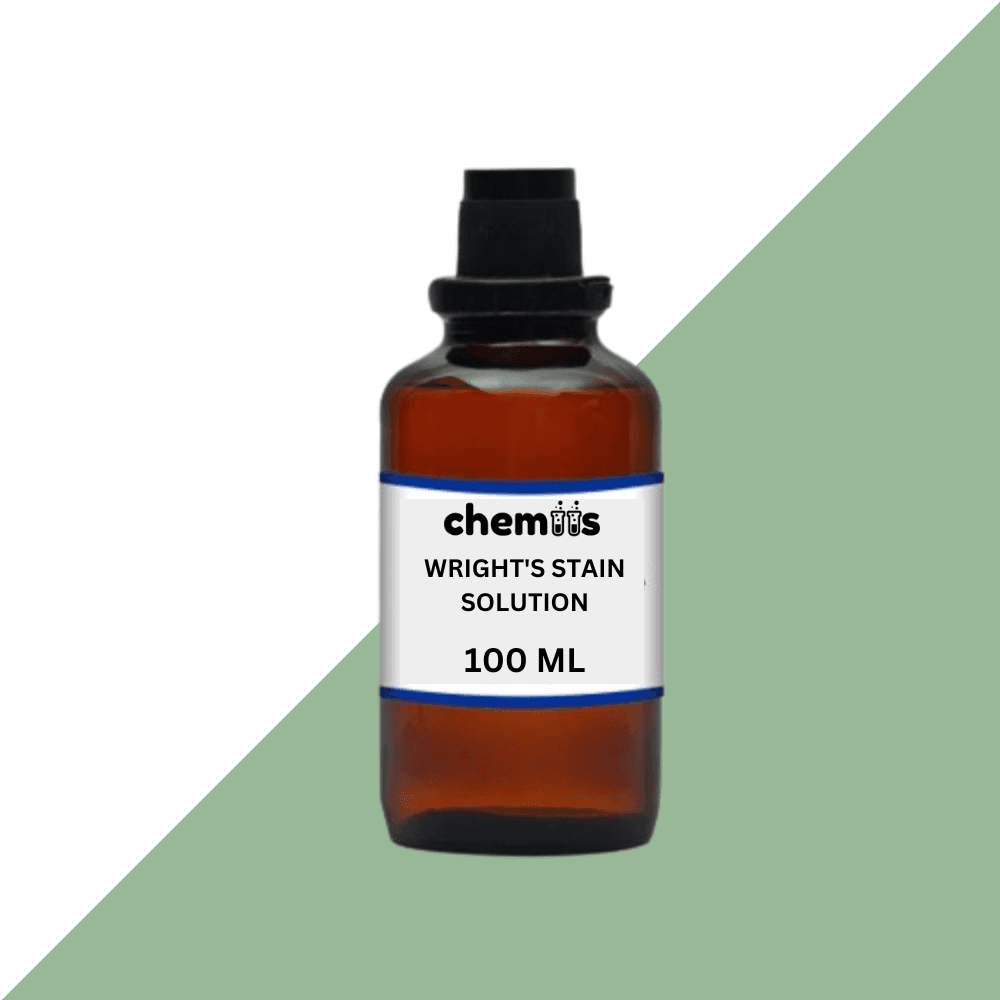Wright’s Stain Solution is a specialized, laboratory-grade reagent primarily used in the preparation and examination of blood smears for microscopic analysis. It is a mixture of eosin and methylene blue, with a slight acidic pH, commonly used in hematology labs. This stain enables the differentiation of various blood cell types and components, such as red blood cells, white blood cells, and platelets, by creating a contrast that enhances their visibility under the microscope.
Wright’s stain has been widely used in both clinical and research settings for diagnostic purposes, particularly in the analysis of blood and bone marrow samples. It is a crucial tool for the identification of various blood disorders, including leukemia, anemia, and malaria.
Applications of Wright’s Stain Solution
1. Blood Smear Staining
- Differentiation of Blood Cells:
The primary application of Wright’s Stain Solution is in the examination of blood smears. The stain allows for the differentiation of the various blood cells—such as red blood cells (RBCs), white blood cells (WBCs), and platelets—based on their distinctive coloration.- Red Blood Cells (RBCs): Typically appear light pink or reddish, allowing easy differentiation from other cell types.
- White Blood Cells (WBCs): Differ in color, with granules in some types (e.g., neutrophils, eosinophils, and basophils) standing out, and nuclei of different shapes (e.g., round, lobulated).
- Platelets: Appear as small, colorless fragments scattered among the cells.
2. Identification of Blood Disorders
- Leukemia Diagnosis:
Wright’s Stain is crucial for detecting abnormalities in white blood cell count and morphology. It can help in diagnosing conditions like leukemia, where there are abnormal or immature white blood cells present in the blood. - Anemia and Blood Disorders:
The stain allows for the observation of changes in the shape, size, and color of red blood cells, which can indicate conditions such as anemia, sickle cell disease, and thalassemia. - Malaria Detection:
Wright’s Stain can also be used to identify malaria parasites in red blood cells. The parasitic forms such as Plasmodium species show up clearly when stained with Wright’s stain, assisting in the diagnosis of malaria.
3. Bone Marrow Examination
- Bone Marrow Smears:
Wright’s Stain is employed in the examination of bone marrow smears to assess hematopoietic activity (blood cell production). It aids in detecting abnormalities like anemia, leukopenia, and other hematologic disorders by providing clear, differentiated images of the cells present in the marrow.
4. Research and Educational Purposes
- Educational Tool for Cytology and Hematology:
Wright’s Stain is an essential tool for medical students and laboratory technicians in training, helping them understand the structure and morphology of blood cells. It is commonly used in educational settings for cytological studies. - Research Applications:
Wright’s Stain can also be used in scientific research to study the characteristics of blood cells, blood-related diseases, and the effects of drugs or treatments on blood cells.
5. Diagnostic Microscopy
- Microscopic Examination:
In clinical laboratories, Wright’s Stain is used in conjunction with light microscopy to identify and count blood cell types. It is instrumental in diagnosing and monitoring the progression of various blood disorders.
Safety and Handling of Wright’s Stain Solution
1. Hazards and Safety Information
- Toxicity:
Wright’s Stain Solution contains methylene blue and eosin, which can be harmful if ingested, inhaled, or absorbed through the skin. It is crucial to follow safety protocols to avoid exposure. - Skin Contact:
Prolonged contact with Wright’s Stain can cause irritation or staining of the skin. Although not highly toxic, it is essential to wear gloves to prevent staining and minimize skin contact. - Eye Contact:
If the stain comes into contact with the eyes, rinse immediately with copious amounts of water for at least 15 minutes. If irritation persists, seek medical attention. - Inhalation:
Avoid inhaling vapors or aerosols from the stain. If inhaled, move to an area with fresh air and seek medical help if respiratory irritation or difficulty occurs.
2. Personal Protective Equipment (PPE)
- Gloves:
Always wear disposable gloves when handling Wright’s Stain Solution, as it can stain the skin and may cause irritation with prolonged contact. - Safety Goggles:
Protective goggles should be worn to prevent accidental splashes into the eyes during the preparation and application of the stain. - Lab Coat or Protective Clothing:
Wear a lab coat or protective clothing to avoid staining clothes or coming into direct contact with the solution.
3. Storage and Handling
- Storage Instructions:
Wright’s Stain Solution should be stored in a cool, dry place, away from heat and direct light. The container should be tightly sealed to maintain the stability and integrity of the solution. - Handling Instructions:
When handling the stain, it is important to use it in a well-ventilated area, especially if working with large quantities or in a laboratory with numerous open containers. Ensure that work surfaces are protected to avoid staining.
4. Disposal Instructions
- Waste Disposal:
Dispose of Wright’s Stain Solution and any contaminated materials (such as gloves, pipettes, and slides) in accordance with local regulations. Do not pour the stain down drains or dispose of it in regular trash. - Spill Cleanup:
In case of a spill, absorb the solution with an absorbent material (e.g., paper towels or absorbent pads). Clean the affected area with water and a mild detergent to remove residual stain.
5. First Aid Measures
- Skin Contact:
Wash the affected area with soap and water. If irritation occurs or staining persists, consult a medical professional for further advice. - Eye Contact:
Rinse eyes immediately with water for at least 15 minutes. Seek medical attention if irritation continues or if vision problems arise. - Inhalation:
If inhaled, move to fresh air immediately. Seek medical attention if any respiratory distress occurs or symptoms persist.


















Reviews
Clear filtersThere are no reviews yet.